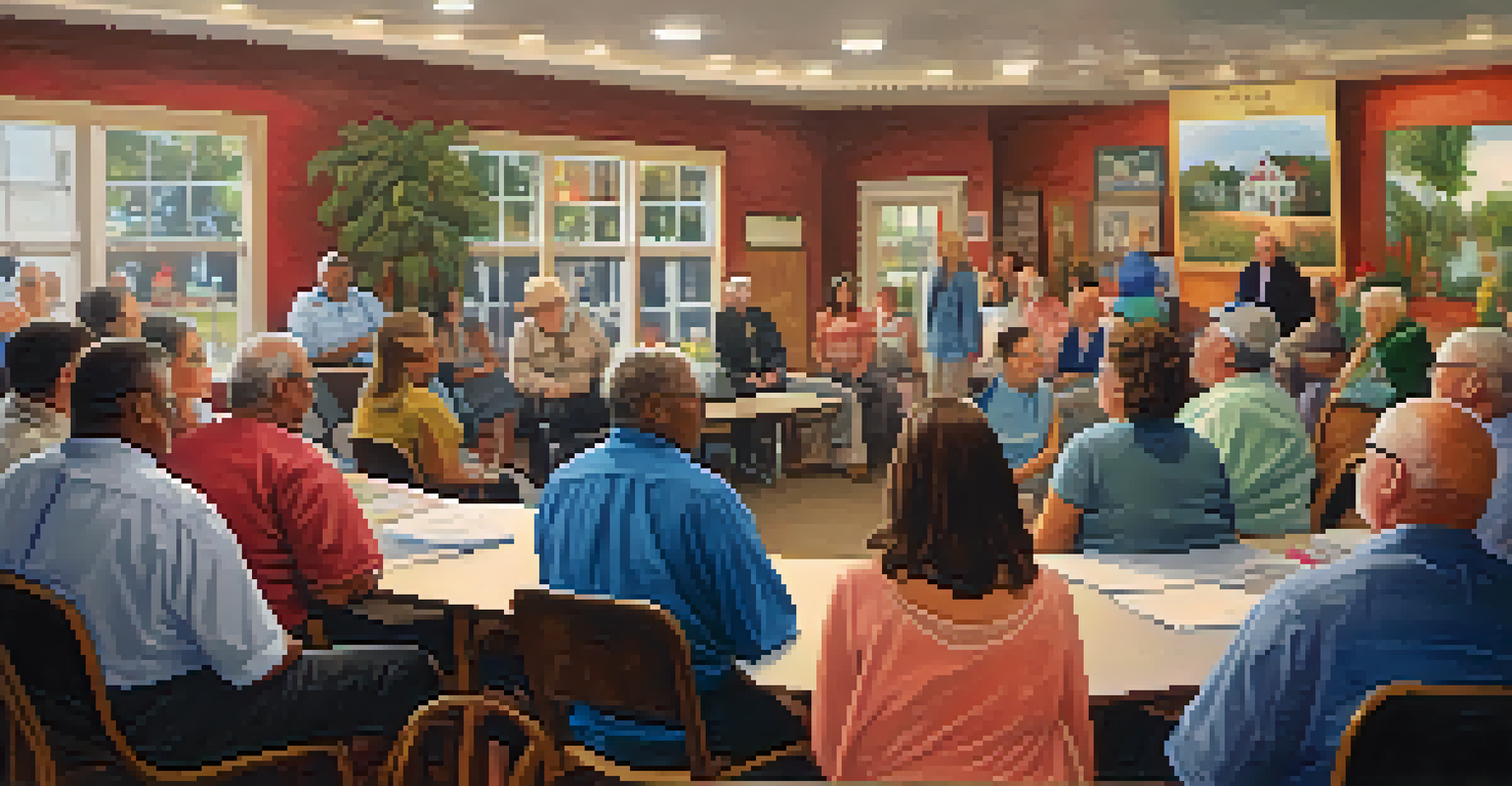Florida's Political Divides: Urban vs. Rural Voting Patterns

Understanding Florida's Political Landscape
Florida is often seen as a microcosm of America, with its diverse population and booming cities alongside sprawling rural areas. This geographic split plays a significant role in shaping political opinions and voting behaviors. As a result, understanding these dynamics is crucial for anyone trying to navigate Florida's political landscape.
Florida is often seen as a microcosm of America, with its diverse population and booming cities alongside sprawling rural areas.
Urban areas, like Miami and Orlando, tend to lean more Democratic, while rural regions, such as the Panhandle, often favor Republican candidates. This division can be traced back to various factors, including demographics, economic opportunities, and cultural backgrounds. Recognizing these distinctions helps in grasping the broader electoral patterns in the state.
Moreover, the political divide is not merely a reflection of party preference; it also reveals deeper social issues. Issues such as education, healthcare, and economic disparity resonate differently in urban vs. rural settings, influencing voter priorities and loyalties.
Demographics: Who Votes Where?
Demographics play a pivotal role in shaping the voting patterns across Florida. Urban areas are characterized by a younger, more diverse population, often with higher levels of education. This demographic tends to prioritize progressive issues like climate change, social justice, and healthcare reform, driving their voting decisions.

In contrast, rural voters are typically older and more homogenous, often valuing traditional social structures and economic stability. They may prioritize issues such as agricultural policies, gun rights, and local job creation, framing their political choices around these values. This stark difference in demographics is a key factor in the overall electoral divide.
Urban vs. Rural Voting Patterns
Florida's political divide reflects distinct voting behaviors, with urban areas leaning Democratic and rural regions favoring Republican candidates.
Additionally, the variations in population density and diversity mean that urban areas can mobilize large groups of voters quickly, while rural areas might rely more on local networks to encourage turnout. This distinction adds another layer of complexity to understanding voting patterns in Florida.
Key Issues Driving Urban Voter Behavior
In urban centers, several key issues drive voter behavior: affordable housing, public transportation, and education reform are at the forefront. With increasing populations, many urban residents are concerned about the rising cost of living and access to essential services. Consequently, these issues often influence their political affiliations and electoral choices.
Understanding these trends is vital for political strategists, candidates, and voters alike.
Additionally, urban voters are typically more affected by national issues such as immigration and healthcare reform. For instance, the diversity in cities often leads to a more progressive stance on immigration policies, as many residents have personal connections to immigrant communities. These connections shape their perspectives and voting patterns.
Moreover, urban areas frequently experience greater media exposure and political mobilization efforts, amplifying the voices of progressive candidates. This environment creates a feedback loop, where the concerns of urban voters are both acknowledged and acted upon, further solidifying their political leanings.
Key Issues Driving Rural Voter Behavior
Rural voters, on the other hand, often prioritize issues like agriculture, land use, and job security. These topics resonate deeply as many rural residents rely on farming and local industries for their livelihoods. Political candidates who address these concerns tend to gain favor in these communities.
Another significant issue for rural voters is the perception of government overreach, particularly regarding land regulations and gun rights. Many feel that urban politicians do not understand or respect their way of life, leading to a strong preference for candidates who advocate for individual liberties and local governance.
Key Issues Shape Voter Decisions
Different priorities, such as affordable housing for urban voters and agricultural concerns for rural voters, significantly influence electoral choices across the state.
Furthermore, the role of local media cannot be underestimated in rural areas. Local news outlets often focus on community-specific issues, allowing candidates who align with rural values to connect more personally with voters and gain their trust.
The Influence of Media on Voting Patterns
Media plays a crucial role in shaping political perspectives in both urban and rural areas. Urban residents typically consume a wide range of national and international news outlets, leading to a more informed and diverse understanding of political issues. This exposure can foster progressive voting patterns among urban populations.
In contrast, rural areas often rely on local media sources, which may present a more homogeneous viewpoint. These local outlets tend to highlight issues that resonate with rural values, reinforcing conservative perspectives. As a result, rural voters may be less exposed to the broader spectrum of political ideas.
Additionally, the rise of social media has changed the landscape of political communication. Urban voters often engage with diverse viewpoints online, while rural voters might find themselves in echo chambers that amplify their existing beliefs. This dynamic further entrenches the urban-rural divide in Florida's political landscape.
The Role of Political Campaigns
Political campaigns in Florida often reflect the urban-rural divide through targeted messaging and outreach strategies. Campaigns aiming for urban votes may emphasize progressive policies and social issues, while those focused on rural areas often highlight economic stability and traditional values. This strategic differentiation is crucial for candidates seeking to maximize their support.
Moreover, the accessibility of campaign events varies significantly between urban and rural areas. Urban residents may have more opportunities to engage with candidates through town halls and rallies, while rural voters may rely on smaller, community-focused events. This difference in engagement can influence voter turnout and loyalty.
Media's Role in Political Views
Media consumption patterns differ greatly between urban and rural areas, shaping the political perspectives and reinforcing the urban-rural divide.
The effectiveness of campaign strategies also depends on understanding local issues. Candidates who can connect with rural voters on agricultural concerns or urban voters on housing and education are more likely to gain traction. This localized approach is essential for addressing the unique needs of each constituency.
Future Trends in Florida's Political Landscape
As Florida continues to grow and evolve, its political landscape will undoubtedly shift. Urban areas are likely to see increased diversity and progressive movements, while rural areas may hold steady in their traditional values. However, as younger generations move into rural areas, we may witness a gradual blending of these political identities.
Additionally, issues such as climate change and economic disparities could bridge the divide between urban and rural voters. For instance, rural communities heavily reliant on agriculture may find common ground with urban voters advocating for sustainable practices. This potential for collaboration could reshape Florida's political dynamics.

Ultimately, understanding these trends is vital for political strategists, candidates, and voters alike. By recognizing the unique needs and values of both urban and rural populations, Florida can foster a more inclusive political climate that respects its diverse electorate.